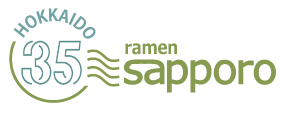Hokkaido Ramen
- There are many local ramen throughout Japan that incorporate the characteristics and food culture of each region!
- Here we introduce some of the most popular ramen that have gained a devoted following in Hokkaido.
1) Sapporo Ramen<Miso>
- Sapporo became crowded with ramen stores starting with yatai (street stall) ramen stores around 1946-22, just after the end of the war.
- At that time, soy sauce flavored pork bone soup was very popular.
- The store of Senji Nishiyama’s 「Daruma-ken」 and the store of Morito Omiya(Aji no Sanpei), who later developed miso ramen, were also yatai stalls.
- Morito Omiya learned ramen from Kanshichi Matsuda and opened 「Aji no Sanpei」.
- Takayuki Nishiyama spun off the noodle-making department of “Daruma-ken” and created thick, curly yellow egg noodles.
- Thus, the original form of “Sapporo Ramen” was created from the encounter between Morito Omiya, Senji Nishiyama, and Takayuki Nishiyama.
- One of the main reasons why Sapporo ramen is so tasty is that the noodles are made using high-quality melted snow water from the Teine Mountains.
- It can be said that there are many famous local ramen in places throughout Japan where the water is good.
- In addition to the traditional「Ramen Yokocho」and 「Shin Ramen Yokocho」 there is the Kotoni area where ramen stores with strong individuality gather.
- A new「Ramen Yokocho」will appear where you can enjoy a variety of ramen from Tokyo-style ramen with clear soup to Kyushu-style ramen with rich broth.
- Sapporo is now a market where various types of ramen compete for flavor.
- No matter where the ingredients and flavors come from, if they are cooked in Sapporo’s water and climate, they are made in Sapporo.
- This is Sapporo ramen.
- Sapporo is the city of ramen forever.
- *Morito Omiya is the founder of 「Aji no Sanpei」.
2) Asahikawa Ramen<Soy Sauce>
- The soup is very simple soy sauce flavored soup, thin noodles, pork, pickled bamboo shoots, and green onions.
- This is the kind of ramen that has been loved for many years in Asahikawa, a city of 400 ramen stores.
- It started around the same time as Sapporo, around 1947.
- Kumasaburo Kato’s son, Edanao, who used to make handmade buckwheat noodles in Teshiomachi, opened a ramen store called 「Hachiya」.
- In the same year, Yoshiya Murayama of「Aoba」also started his own ramen cart with a large cart.
- These two stores are said to be the beginning of Asahikawa ramen as we know it today.
- In 1989,「Heiseiken」opened in Sapporo, and Asahikawa ramen stores began to open in Sapporo one after another.
- The opening of “Heiseiken” in Sapporo in 1989 triggered an Asahikawa ramen boom, and the ramen became well known in Tokyo and throughout Japan.
- The characteristic of Asahikawa ramen is its soup, which is made not only from pork bones but also from marine products.
- Another characteristic of Asahikawa ramen is the thin noodles made with a low water content to bring out the flavor of the flour.
- These noodles absorb the broth, making the noodles themselves tasty and giving them a unique texture.
- Famous restaurants such as「Hachiya」and「Aoba」are still among the best ramen restaurants in Japan, and they continue to delight ramen fans throughout the country.
- The charm of Asahikawa ramen lies in its authentic taste, which has been developed over many years by the local people.
3) Hakodate Ramen<Salt>
- Hakodate Ramen is characterized by its clear soup and thin, straight noodles.
- Hakodate Ramen is characterized by its light, salt-flavored soup.
- Hakodate ramen is the ramen that most closely resembles the Chinese noodle dish of today’s Japan.
- The Chinese House that still exists in Omachi is a reminder of the exchange between Hakodate Ramen and China.
- Opened in 1908, the building housed a Chinese restaurant called「Rantei」.
- From the Meiji to Taisho periods, Chinese food culture flowed into Omachi through this restaurant, and the roots of ramen were established.
- In the early Showa period, ramen appeared as「shina soba」.
- After the war, ramen started at yatai stalls, just like in Sapporo.
- However, the traditions of Chinese cuisine have been carried over here to the present day.
- Even today, Hakodate is characterized by eating ramen at Chinese restaurants rather than ramen specialty stores.
- The soup is a clear, pork-based broth.
- It is important to control the heat to keep the soup from boiling over low heat and to remove the scum frequently.
- Some restaurants also use vegetables, kelp, and chicken bones.
- The ingredients are simply chashu pork, green onions, and bamboo shoots.
- The noodles have a smooth texture and a clean aftertaste.
